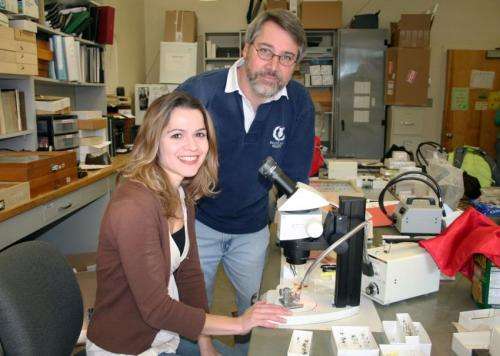Westward Ho! American Entomological Institute to Move to Utah State University

One of the world's most venerated entomological research institutions plans to pull up stakes in its longtime Gainesville, Florida home and move lock, stock and insect collection trays to Utah State University's Logan campus.
A memorandum of understanding crafted between the American Entomological Institute and USU officially seals plans for the transfer, which includes a $1.8 million endowment to support a curator and collection maintenance, as well as more than a million specimens. The unprecedented move is slated for spring 2016.
"This donation increases the USU Insect Collection's wasp holdings by 50 percent," says Jim MacMahon, dean of USU's College of Science and trustee professor in the Department of Biology, which will oversee the collection. "But more than that, it positions Utah State as an entomological research nexus, creating invaluable learning opportunities for our students."
Established by private collectors and scientists Henry and Marjorie Townes in 1934, the non-profit institute houses one of the world's largest collections of the insect order Hymenoptera, which includes wasps, bees, ants and sawflies. The collection has more than 1.2 million specimens, including 3,650 holotypes – that is, unique specimens on which new scientific names are based.
"The gift of the internationally prominent AEI collection greatly enhances what is already a well-recognized program in the biology of Hymenoptera at Utah State," says Alan Savitzky, professor and head of USU's Department of Biology.
In fact, the institute's decision to move its vast collection is largely due to the particular expertise found at Utah State, namely the USDA Bee Biology and Systematics Laboratory and USU entomologist James Pitts. Curator of the USU Entomology Collection and associate professor in the Department of Biology, Pitts is one of the world's leading entomologists specializing in the study of Mutillidae, a family of more than 3,000 wasp species known as "velvet ants" and Pompilidae, a family of more than 5,000 insects known as "spider wasps."
Pitts' colleague Carol von Dohlen, USU professor of biology, also studies Hymenoptera extensively.
"Having this collection will take our research to the next level," Pitts says. "It will bring visiting scientists from around the world to our campus and enable our students and faculty to interact with top entomological scholars."
As part of the donation agreement, current AEI curator David Wahl will relocate to USU and continue in his post. Wahl's research focuses on the systematics and taxonomy of Ichneumonidae, a family of wasp species known as "ichneumons" or parasitic wasps.
"The collection's focus on Ichneumonidae will significantly expand our coverage of that extraordinarily diverse and ecologically important group of wasps," Savitzky says. "We are especially delighted to welcome Dr. Wahl, who will join our team of entomologists already serving in the Department of Biology and the USDA Bee Biology and Systematics Laboratory."
Insects are ideal for lab and classroom study because they're small, Pitts says. "But they're as effective as specimens of much larger animals in teaching critical concepts in genetics, evolution and ecology and providing models for research."
The move also includes relocating the printed stock of AEI's peer-reviewed publication, "Memoirs of the American Entomological Institute," to USU. Established in 1961, the research journal focuses on arthropod systematics.
The mission of the AEI, according to its website, is to embody Henry and Marjorie Townes' enthusiastic vision of increasing human understanding of the biological diversity of parasitic wasps, an enormous group of crucial importance in both natural and agricultural ecosystems. The primary focus is on maintaining, organizing and augmenting the large and irreplaceable collection of the Institute, and making this collection a focus of research, accessible to a world community of biologists dedicated to the goal of revealing the scope and patterns of diversity in the Hymenoptera.
More information:
James Pitts (USU), 435-797-8872, james.pitts@usu.edu
David Wahl (AEI), 352-377-6458, aei@aei.cfcoxmail.com
Alan Savitzky (USU), 435-797-1909, savitzky@usu.edu
Mary-Ann Muffoletto, 435-797-3517, maryann.muffoletto@usu.edu
Provided by Utah State University